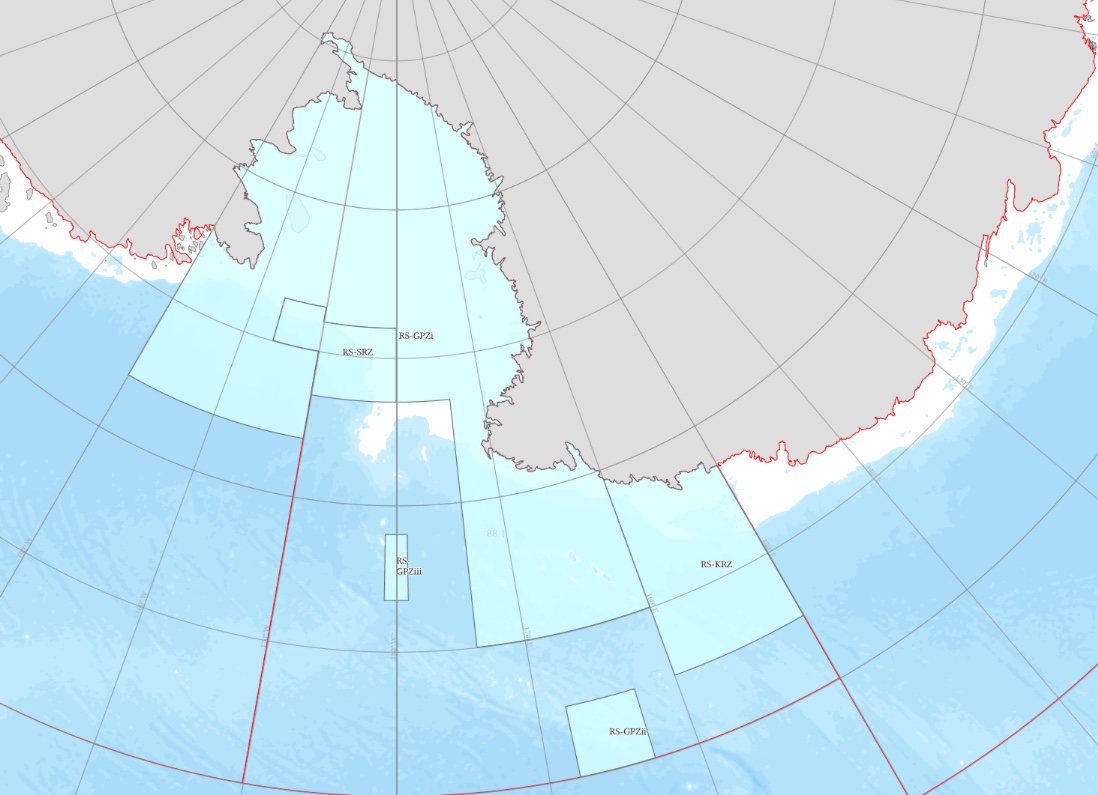The Ross Sea region Marine Protected Area (RSr MPA) was originally proposed in 2012, and agreed by CCAMLR in 2016 under CM 91-05, with the MPA coming into force on 1 December 2017. The RSrMPA is the world’s largest MPA covering 2.09 million square kilometres. The MPA is divided into three zones, the General Protection Zone (GPZ), the Special Research Zone (SRZ) and the Krill Research Zone (KRZ), each of which allows certain activities and restricts others. Fishing activities are prohibited within much of the MPA with a few exceptions, all of which must be conducted in accordance with other Conservation Measures set down by CCAMLR.
The MPA aims to protect large-scale ecosystem processes, conserve biodiversity, protect predators and prey (including penguins, seals, whales, krill and Antarctic silverfish), protect areas of ecological importance, protect areas that are important to the life cycle of Antarctic toothfish, and promote research and other scientific activities (such as monitoring) on the marine living resources in the region. The RSrMPA remains in force until the end of its review period in 2052, at which time it may be renewed or modified as needed.
The specific objectives for the research and monitoring plan associated with the RSrMPA fall into three main categories:
(i) representativeness - research and monitoring to assess whether the RSrMPA is protecting an adequate proportion of all benthic and pelagic environments in the Ross Sea region
(ii) threat mitigation - research and monitoring to assess the extent to which threats to the achievement of Article II.3 and the specific objectives of the RSrMPA are being effectively avoided or mitigated by the MPA, in locations where the risk of ecosystem impacts from harvesting activities may otherwise be high
(iii) scientific reference areas - research and monitoring where the RSrMPA provides opportunities to examine Antarctic marine ecosystems where no, or limited, fishing has taken, or is taking, place, to understand, for example, the effects of fishing, environmental variability and climate change on Antarctic marine living resources.
Member activity reports
In accordance with Conservation Measure 91-05, paragraph 15, Members are asked to submit a report every five years on their activities conducted according to, or related to, the MPA Research and Monitoring Plan, including any preliminary results. All Member activity reports within the Ross Sea region submitted to the Secretariat by March 2022 are therefore provided through the below link:
https://www.ccamlr.org/en/document/science/cmir-member-activity-reports-rsrmpa
This compilation was also submitted as a supplementary document to WG-EMM-2022, to accompany WG-EMM-2022/37 (Summary of the CCAMLR MPA Information Repository (CMIR)).
- (i) Conserve natural ecological structure (R, T, S)
- (ii) Scientific reference areas - Special Research Zone (SRZ) (S)
- (iii) Promote research (R, T, S)
- (iv)a Representativeness of benthic and pelagic environments - benthic bioregionalisation (R)
- (iv)b Representativeness of benthic and pelagic environments - pelagic bioregionalisation (R)
- (v)a Large scale ecosystem processes/ areas - Ross Sea shelf front intersection with seasonal ice (T)
- (v)b Large scale ecosystem processes/ areas - Polar Front (T)
- (v)c Large scale ecosystem processes/ areas - Balleny Islands and proximity (T)
- (v)d Large scale ecosystem processes/ areas - Ross Sea polynya Marginal Ice Zone (T)
- (v)e Large scale ecosystem processes/ areas - Eastern Ross Sea multi-year ice (T)
- (vi)a Trophically dominant pelagic prey species - Antarctic krill core distribution (T)
- (vi)b Trophically dominant pelagic prey species - Crystal krill core distribution (T)
- (vi)c Trophically dominant pelagic prey species - Antarctic silverfish core distribution (T)
- (vii)a Key top predator foraging distributions - Adélie penguin summer core foraging distribution (T)
- (vii)b Key top predator foraging distributions - Emperor penguin summer core foraging distribution (T)
- (vii)c Key top predator foraging distributions - Weddell seal summer core foraging distribution (T)
- (vii)d Key top predator foraging distributions - Type C killer whale core summer foraging distribution (T)
- (viii)a Coastal/ localised areas of particular ecosystem importance - Southern Ross Sea shelf persistent (T)
- (viii)b Coastal/ localised areas of particular ecosystem importance - Coastal polynyas (T)
- (viii)c Coastal/ localised areas of particular ecosystem importance - Terra Nova Bay (including the TNB polynya) (T)
- (viii)d Coastal/ localised areas of particular ecosystem importance - Victoria coast, coastal buffer and platelet ice formation (T)
- (viii)e Coastal/ localised areas of particular ecosystem importance - Pennell Bank polynya (T)
- (ix)a Dissostichus mawsoni life cycle areas - Sub-adult toothfish settlement areas on the Ross Sea shelf (T)
- (ix)b Dissostichus mawsoni life cycle areas - Dispersal trenches for maturing toothfish (T)
- (ix)c Dissostichus mawsoni life cycle areas - Adult feeding areas on the Ross Sea continental slope (T)
- (ix)d Dissostichus mawsoni life cycle areas - Toothfish spawning/ life cycle (T)
- (x)a Rare or vulnerable benthic habitats - Balleny Islands and adjacent seamounts (T)
- (x)b Rare or vulnerable benthic habitats - Admiralty Seamount (T)
- (x)c Rare or vulnerable benthic habitats - Cape Adare proximity continental slope (T)
- (x)d Rare or vulnerable benthic habitats - Southeast Ross Sea continental slope (T)
- (x)e Rare or vulnerable benthic habitats - Southern McMurdo Sound (T)
- (x)f Rare or vulnerable benthic habitats - Scott Seamount (T)
- (xi) Promote research of Antarctic krill - Krill Research Zone (KRZ) (S)
Baseline data layers used for spatial planning, monitoring and research in relation to the Ross Sea region Marine Protected Area - Refer to WS-SM-18/01
Updated baseline data layers used for spatial planning, monitoring and research in relation to the Ross Sea region Marine Protected Area - Refer to SC-CAMLR-XXXVII/11 and SC-CAMLR-XXXVII/BG/13

